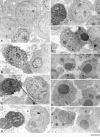Ligation of major histocompatability complex (MHC) class I molecules on human T cells induces cell death through PI-3 kinase-induced c-Jun NH2-terminal kinase activity: a novel apoptotic pathway distinct from Fas-induced apoptosis
- PMID: 9396757
- PMCID: PMC2132618
- DOI: 10.1083/jcb.139.6.1523
Ligation of major histocompatability complex (MHC) class I molecules on human T cells induces cell death through PI-3 kinase-induced c-Jun NH2-terminal kinase activity: a novel apoptotic pathway distinct from Fas-induced apoptosis
Abstract
Ligation of major histocompatability complex class I (MHC-I) molecules expressed on T cells leads to both growth arrest and apoptosis. The aim of the current study was to investigate the intracellular signal pathways that mediate these effects. MHC-I ligation of human Jurkat T cells induced a morphologically distinct form of apoptosis within 6 h. A specific caspase inhibitor, which inhibited Fas-induced apoptosis, did not affect apoptosis induced by MHC-I ligation. Furthermore, MHC-I-induced apoptosis did not involve cleavage and activation of the poly(ADP- ribose) polymerase (PARP) endonuclease or degradation of genomic DNA into the typical fragmentation ladder, both prominent events of Fas-induced apoptosis. These results suggest that MHC-I ligation of Jurkat T cells induce apoptosis through a signal pathway distinct from the Fas molecule. In our search for other signal pathways leading to apoptosis, we found that the regulatory 85-kD subunit of the phosphoinositide-3 kinase (PI-3) kinase was tyrosine phosphorylated after ligation of MHC-I and the PI-3 kinase inhibitor wortmannin selectively blocked MHC-I-, but not Fas-induced, apoptosis. As the c-Jun NH2-terminal kinase (JNK) can be activated by PI-3 kinase activity, and has been shown to be involved in apoptosis of lymphocytes, we examined JNK activation after MHC-I ligation. Strong JNK activity was observed after MHC-I ligation and the activity was completely blocked by wortmannin. Inhibition of JNK activity, by transfecting cells with a dominant-negative JNKK- MKK4 construct, led to a strong reduction of apoptosis after MHC-I ligation. These results suggest a critical engagement of PI-3 kinase-induced JNK activity in apoptosis induced by MHC-I ligation.
Figures














Similar articles
-
The oncogenic TEL/PDGFR beta fusion protein induces cell death through JNK/SAPK pathway.Oncogene. 1999 Jul 1;18(26):3878-85. doi: 10.1038/sj.onc.1202734. Oncogene. 1999. PMID: 10445851
-
Ligation of major histocompatibility complex class I antigens (MHC-I) prevents apoptosis induced by Fas or SAPK/JNK activation in T-lymphoma cells.Tissue Antigens. 2001 Sep;58(3):171-80. doi: 10.1034/j.1399-0039.2001.580305.x. Tissue Antigens. 2001. PMID: 11703825
-
MEK1 activation rescues Jurkat T cells from Fas-induced apoptosis.Cell Immunol. 1999 May 25;194(1):67-77. doi: 10.1006/cimm.1999.1486. Cell Immunol. 1999. PMID: 10357882
-
Signaling by the JNK group of MAP kinases. c-jun N-terminal Kinase.J Clin Immunol. 2001 Jul;21(4):253-7. doi: 10.1023/a:1010975124110. J Clin Immunol. 2001. PMID: 11506194 Review.
-
Effector pathways regulating T cell activation.Biochem Pharmacol. 1998 Dec 15;56(12):1539-47. doi: 10.1016/s0006-2952(98)00213-5. Biochem Pharmacol. 1998. PMID: 9973174 Review.
Cited by
-
A monoclonal antibody to the alpha2 domain of murine major histocompatibility complex class I that specifically kills activated lymphocytes and blocks liver damage in the concanavalin A hepatitis model.J Exp Med. 2003 Aug 4;198(3):497-503. doi: 10.1084/jem.20021301. Epub 2003 Jul 28. J Exp Med. 2003. PMID: 12885869 Free PMC article.
-
Cab45S inhibits the ER stress-induced IRE1-JNK pathway and apoptosis via GRP78/BiP.Cell Death Dis. 2014 May 8;5(5):e1219. doi: 10.1038/cddis.2014.193. Cell Death Dis. 2014. PMID: 24810055 Free PMC article.
-
Reverse Signaling by MHC-I Molecules in Immune and Non-Immune Cell Types.Front Immunol. 2020 Dec 15;11:605958. doi: 10.3389/fimmu.2020.605958. eCollection 2020. Front Immunol. 2020. PMID: 33384693 Free PMC article. Review.
-
A novel, alternative pathway of apoptosis triggered through class II major histocompatibility complex molecules.J Mol Med (Berl). 2003 Dec;81(12):757-65. doi: 10.1007/s00109-003-0489-9. Epub 2003 Oct 9. J Mol Med (Berl). 2003. PMID: 14551703 Review.
-
HLA class I binding 9mer peptides from influenza A virus induce CD4 T cell responses.PLoS One. 2010 May 7;5(5):e10533. doi: 10.1371/journal.pone.0010533. PLoS One. 2010. PMID: 20479886 Free PMC article.
References
-
- Apasov S, Redegeld F, Sitkovsky M. Cell-mediated cytotoxicity: contact and secreted factors. Curr Opin Immunol. 1993;5:404–410. - PubMed
-
- Beckwith M, Fenton RG, Katona IM, Longo DL. Phosphatidylinositol-3-kinase activity is required for the anti–ig-mediated growth inhibition of a human B-lymphoma cell line. Blood. 1996;87:202–210. - PubMed
-
- Bregenholt S, Röpke M, Skov S, Claesson MH. Ligation of MHC class I molecules on peripheral blood T lymphocytes induces new phenotypes and functions. JImmunol. 1996;157:993–999. - PubMed
Publication types
MeSH terms
Substances
LinkOut - more resources
Full Text Sources
Other Literature Sources
Research Materials
Miscellaneous

